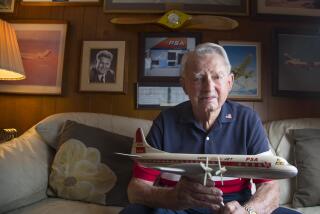Robert Hedrix, 81; symbol of the collapse of South Vietnam
- Share via
One of the most arresting images from the last days of the Vietnam War shows an unruly crowd rushing the door of a plane in Nha Trang, a rural seaside city north of Saigon. The focal point of the photograph is a balding, middle-aged American who is landing a jab to the head of a Vietnamese man desperate to board.
The American is all grim determination; his jaw is clenched as he lunges right, extending his arm like a ramrod into the face of the intruder. Resolute in the crush of bodies, he is a bulwark in the bedlam of a turbulent era’s violent finale.
The caption accompanying the UPI photo identified him only as an American official, but he was actually a charter pilot hired by the State Department to move Americans from the countryside to Saigon.
In 1985, after People magazine ran the photo with a story on the 10th anniversary of Saigon’s fall, some of his war-era buddies identified him: He was Robert D. Hedrix, a North Dakota native and veteran of World War II and the Korean War who spent most of the 1950s, ‘60s and ‘70s in and around Southeast Asia as a pilot for the Air Force, the CIA and various commercial outfits.
“He was a real warrior. He felt it was his calling to fight on behalf of America,” his son-in-law, Phil Hernandez, said in an interview last week.
Hedrix, who returned to the United States in 1977 and flew planes for the Bureau of Land Management and the U.S. Forest Service, died of a heart attack last month at 81, according to his family. He had been dead for a few days when his landlord found his body Oct. 25 in his home in Lafayette, Colo.
Buried Friday at Ft. Snelling National Cemetery in Minneapolis, he is survived by a daughter, Mary Hernandez; two sons, Mike and John; nine grandchildren; and three great-grandchildren.
Hedrix rarely talked about his Vietnam experiences, even though the photograph in which he played a starring role was widely reprinted over the years.
It was taken April 1, 1975, when South Vietnam’s capitulation was only a matter of time. The North Vietnamese army was sweeping south toward Saigon, and Nha Trang was among the cities falling like dominoes.
Hedrix had been hired to transport Americans but if room allowed, he also evacuated Vietnamese: the sick, the elderly and children. In Nha Trang that day, one mother handed him her twins, only a few weeks old, and begged him to take them. “The sacrifice was heartbreaking,” he told People magazine in 1985.
With defeat imminent, soldiers were deserting the South Vietnamese army in droves, disguising themselves in civilian clothes and joining the panicked exodus. Hedrix was alert to their presence. Referring to the famous photograph, he told People: “I’m pretty sure the guy I’m throwing off is a deserter because I could see a pistol stuffed under his belt.”
Hedrix’s plane, a DC-6, took off amid gunfire with 264 passengers, almost 150 over the official capacity. He would log more than 100 flights that month before he left South Vietnam for good April 30, the day Saigon collapsed.
Years later, he told an interviewer that the photo brought one word to his mind: security.
“These people didn’t have it,” he said of the Vietnamese. “People walking down the streets of America do.”
As for the man he slugged outside that plane, he said: “I feel sorry for those guys now.”
More to Read
Sign up for Essential California
The most important California stories and recommendations in your inbox every morning.
You may occasionally receive promotional content from the Los Angeles Times.











